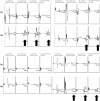Low-dose sevoflurane co-administered with propofol-based general anaesthesia obliterates intra-operative neurophysiological monitoring in an infant
- PMID: 37700794
- PMCID: PMC10493166
- DOI: 10.1002/anr3.12244
Low-dose sevoflurane co-administered with propofol-based general anaesthesia obliterates intra-operative neurophysiological monitoring in an infant
Abstract
The influence of general anaesthetic agents on intra-operative neurophysiological monitoring in neonates and infants has rarely been reported. Propofol-based anaesthesia is recommended to avoid suppression of neurophysiological monitoring. However, the administration of propofol in children undergoing prolonged procedures, especially those younger than six months, should be carefully controlled due to the potential risk of propofol infusion syndrome. Adding a small dose of inhalational anaesthetic can be an option to reduce propofol requirements. Recent guidelines in Japan suggest limiting inhalational anaesthetics to less than 0.5 minimum alveolar concentrations when co-administered with low-dose propofol during intra-operative neuromonitoring. However, there is still insufficient evidence regarding the impact of sevoflurane on neurophysiological monitoring when co-administered with propofol in infants. This report describes a case of a three-month-old infant undergoing spinal lipoma resection in which there was a dramatic suppression of neurophysiological monitoring with the addition of 0.35-0.45% sevoflurane to propofol-based anaesthesia.
Keywords: infants; intraoperative neurophysiological monitoring; motor evoked potentials; sevoflurane; total intravenous anaesthesia.
© 2023 Association of Anaesthetists.
Figures

References
-
- Bidkar PU, Thakkar A, Manohar N, Rao KS. Intraoperative neurophysiological monitoring in paediatric neurosurgery. International Journal of Clinical Practice 2021; 75: e14160. - PubMed
-
- Aydinlar EI, Dikmen PY, Kocak M, Baykan N, Seymen N, Ozek MM. Intraoperative neuromonitoring of motor‐evoked potentials in infants undergoing surgery of the spine and spinal cord. Journal of Clinical Neurophysiology 2019; 36: 60–66. - PubMed
-
- Udayakumaran S, Nair NS, George M. Intraoperative neuromonitoring for tethered cord surgery in infants: challenges and outcome. Pediatric Neurosurgery 2021; 56: 501–510. - PubMed
-
- Gisi G, Borab OF. Anesthesia management during meningomyelocele repair alongside motor‐evoked potentials in a newborn and a small infant. Child's Nervous System 2020; 36: 3053–3057. - PubMed
-
- Lotto ML, Banoub M, Schubert A. Effects of anesthetic agents and physiologic changes on intraoperative motor evoked potentials. Journal of Neurosurgical Anesthesiology 2004; 16: 32–42. - PubMed
Publication types
LinkOut - more resources
Full Text Sources
